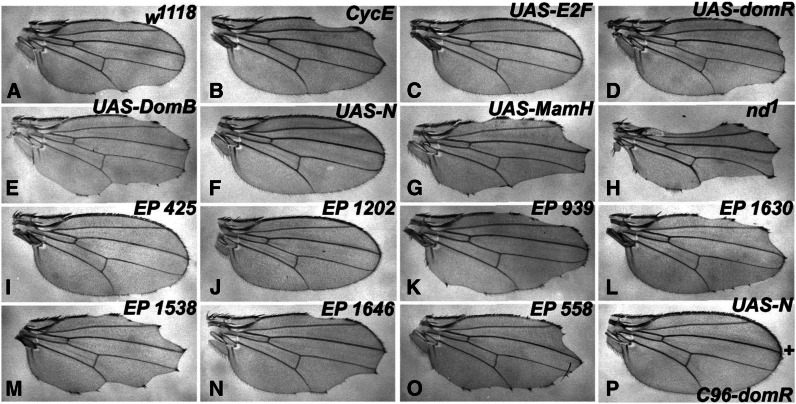Figure 7.
Interactions of the C96+Rbf280 proliferation-defective genotype. In the descriptions below, numbers in parentheses indicate percentage of nicked wings and number of wings scored (N). (A) (30%, N = 440) shows that a constitutively active form of Rbf (Rbf-280) driven across the wing margin via C96-GAL4 (UAS-Rbf-280 + C96-GAL4/+, referred to here as C96+Rbf280) creates a partially penetrant, dominant wing nicking phenotype as a heterozygote with w1118. (B–O) Wings transheterozygous with C96+Rbf280. (B) (64%, N = 120) shows an enhanced wing phenotype via combination with cycEAR95; (C) (18%, N = 86) shows partial rescue in combination with UAS-E2F. Both the UAS-domR RNAi transgene (D) (77%, N = 164) and the UAS-DomB transgene (E) (68%, N = 166) elicit strong enhancement. UAS-DomB did not elicit wing nicking in control crosses to C96-GAL4, data not shown (0%, N = 120). (F) (2%, N = 360) Nearly complete suppression of the wing phenotype by coexpression of an activated Notch construct, UAS-N, whereas depressed Notch signaling via UAS-MamH (G) (100%, N = 174) or the hemizygous viable nd1 allele (H) (100%, N = 274) strongly enhance. (I–O) C96+Rbf280 wings transheterozygous with EP modifiers from the screen: EP 425 tara (I) (10%, N = 124), EP 1202 atg1 (J) (2%, N = 56), EP 939 EcR (K) (92%, N = 52), EP 1630 lilli (L) (70%, N = 146), EP 1538 lola (M) (98%, N = 50), EP 1646 pum (N) (72%, N= 116), EP 558 pabp2 (O) (80%, N = 54). (P) (0%, N = 253) Complete suppression of the C96-domR wing nicking by coexpression of the activated Notch construct UAS-N. See Figure 2B legend for C96-domR wing phenotype. The penetrance of wing nicking in panels B–P is significantly different than w1118 control crosses (P < 0.01, chi-square test).

